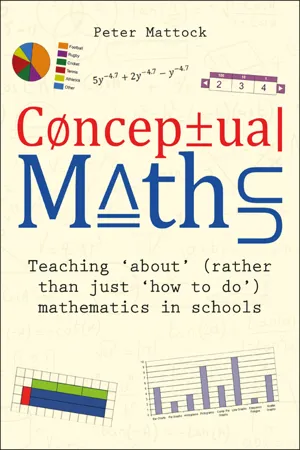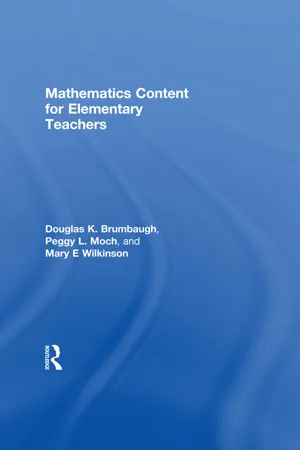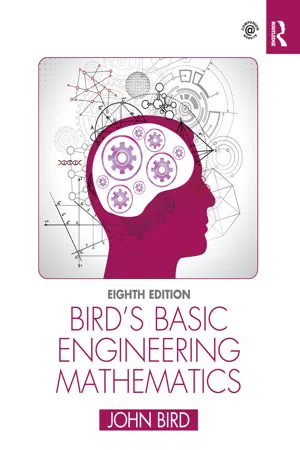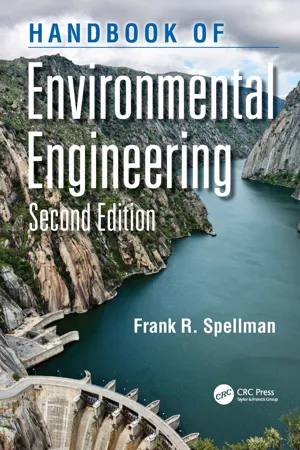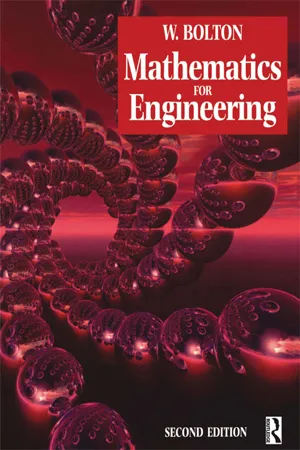Mathematics
Volume of Cylinder
The volume of a cylinder is the amount of space it occupies and is calculated using the formula V = πr^2h, where V represents the volume, π is a constant (approximately 3.14159), r is the radius of the cylinder's base, and h is the height of the cylinder. This formula allows for the quick and accurate determination of a cylinder's volume in mathematical calculations.
Written by Perlego with AI-assistance
Related key terms
9 Key excerpts on "Volume of Cylinder"
- eBook - ePub
Conceptual Maths
Teaching 'about' (rather than just 'how to do') mathematics in schools
- Peter Mattock(Author)
- 2023(Publication Date)
- Crown House Publishing(Publisher)
.Similarly, the volume of a cone can be found by treating it as analogous to a pyramid, being a third of the volume of the containing cylinder. However, it is more difficult to visualise this than with a square or rectangular pyramid (where we can show pyramids attached to the side of the prism as well as the base); however, there are nice video demonstrations that involve filling a cone-shaped container with water and pouring it into a cylindrical container with the same base circle (as demonstrated in the video linked below27 ).This leads to the volume of the cone formula being equal to πr2 h, or alternatively . One thing that pupils need to be clear on here is the use of the vertical height when calculating the volume of a cone, which is in contrast to the use of the slant height when calculating the curved surface area. Offering pupils opportunities to work with both of these is important to make sure pupils use the correct lengths in the correct situations.When it comes to finding the volume of the sphere, again typically calculus would be used to derive the formula; however, there are similar demonstrations to the one above: particularly showing that the sphere of radius r (and therefore diameter 2r) can be filled with a cone with height 2r (and therefore volume of πr3 ) twice over leading to the conclusion that the volume of the sphere can be calculated by πr3 .28 There is also a derivation of the formula that doesn’t require calculus, but does require Pythagoras’ theorem and a reasonable amount of geometric knowledge and insight. The proof rests around demonstrating that when a hemisphere is placed inside a cylinder with the same height and radius (as per the next image) it is possible to show that the space inside the cylinder outside of the hemisphere is equal to the space taken up by a cone with the same radius and height as the cylinder.389 - eBook - ePub
- Andre Castagna(Author)
- 2021(Publication Date)
- Barrons Educational Services(Publisher)
V = Bh to calculate the volume of the prism.Circular Cylinders
A circular cylinder is a solid figure with two parallel and congruent circular bases and a curved lateral surface. The height is the perpendicular distance between the bases. As with the prisms, cylinders can be right or oblique. Figure 12.3 shows each type of cylinder.Figure 12.3 CylinderVolume of a Circular Cylinder
Volume (V) = πr2 hwhere r is the radius of the base and h is the height.Example 1
A right circular cylinder has a diameter of 10 cm and a height of 5 cm. Find the volume. Express your answers in terms of π.Solution:We can work backward to find the height or the radius given the volume of a cylinder.Example 2
A right circular cylinder has a volume of 200 in.3 If the height of the cylinder is 6 in., what is the radius of the cylinder? Round your answer to the nearest hundredth.Solution: Set up the formula for volume. Substitute the known values. Then solve for the radius.Passage contains an image
12.2 Cones, Pyramids, and Spheres
Key Ideas
A circular cone is a solid with one circular base and an apex. A pyramid is a solid with one polygonal base and an apex. A sphere is the solid that is the set of all points a fixed distance from a center point.Circular Cone Pyramid Sphere Volume (V) B is the area of the base, h is the height Circular Cones
A circular cone is a solid with one circular base and a curved lateral surface that comes to a point at the apex. The height of the cone is the length of the segment from the apex perpendicular to the base. In a right circular cone, the height will intersect at the center of the circular base.Figure 12.4 Right circular coneVolume of a Circular Cone
where r is the radius of the base and h is the height.These formulas are applied in a manner similar to those for the cylinder. The Pythagorean theorem can be used to relate slant height, height, and radius. So if you know any two, you can find the third. - eBook - ePub
- Douglas K. Brumbaugh, Peggy L. Moch, MaryE Wilkinson(Authors)
- 2004(Publication Date)
- Routledge(Publisher)
Fig. 5.20 to find the volume of the cylinder.Fig. 5.20.27. The formula for the volume of a right circular cone is . Use the information in Fig. 5.21 to find the volume of the cone.28. How do the volume formulas in Exercises 26 and 27 compare?Fig. 5.21.29. To find the volume of a regular right polygonal prism, find the area of the top face and multiply by the height. For this exercise, use the formula to find the volume of the right hexagonal prism in Fig. 5.22 .Fig. 5.22.30. The volume of a pyramid also depends on the number of edges on the base. Use and the information in Fig. 5.23 to find the volume of the right square pyramid.CapacityFig. 5.23.Volume, or capacity, is not always measured in cubic units. When was the last time you stopped by a service station to buy a cubic yard of gasoline? The word “gallon” was derived from an Anglo French word, galon, and was standardized by the English in 1215 AD for measuring grain and wine. A gallon represents 213 cubic inches of liquid. When you must consider capacity using the inch/foot/pound system, denominate numbers are useful in dealing with inch/foot/pound units. Consider this example of an addition problem that involves regrouping cups to pints, pints to quarts, and quarts to gallons:Several regroupings are required to complete this exercise. In the first line below the vinculum, you see the sum, 14 gallons, 5 quarts, 2 pints, and 2 cups. In the second line, the 5 quarts have been regrouped to 1 gallon 1 quart, the 2 pints have been regrouped to 1 quart, and the 2 cups have been regrouped to 1 pint. In the third line, the 1 gallon from the quarts column has been added to the 14 gallons, the 1 quart from the pints column has been added to the 1 quart, and the 1 pint from the cups column has been moved to the pint column. The result of all this regrouping is an answer of 15 gallons, 2 quarts, and 1 pint.The capacity unit for the metric system is Liter. Perhaps the most well-known metric measure in the United States is 2 Liters, which is a little more than half a gallon. Many household measuring cups have inch/foot/pound on one side and metric measures on the other. On the handy 4-cup measure, you will find that the 1 L or 1000 mL mark is a bit higher than the 4-cup mark, 750 mL is a bit more than 3 cups, 500 mL is a bit more than 2 cups, and 250 mL is a bit more than 1 cup. As any cook will tell you, the differences in these measures have little effect on a finished meal. You just need to practice using the other side of the measuring cup to become comfortable with either capacity measure. Any measure is only as accurate as the measurer. - eBook - ePub
- John Bird(Author)
- 2019(Publication Date)
- Routledge(Publisher)
Chapter 14 Volumes of common solidsWhy it is important to understand: Volumes of common solidsThere are many practical applications where volumes and surface areas of common solids are required. Examples include determining capacities of oil, water, petrol and fish tanks, ventilation shafts and cooling towers, determining volumes of blocks of metal, ball-bearings, boilers and buoys, and calculating the cubic metres of concrete needed for a path. Finding the surface areas of loudspeaker diaphragms and lampshades provide further practical examples. Understanding these calculations is essential for the many practical applications in engineering, construction, architecture and science.At the end of this chapter, you should be able to:- state the SI unit of volume
- calculate the volumes and surface areas of cuboids, cylinders, prisms, pyramids, cones and spheres
- appreciate that volumes of similar bodies are proportional to the cubes of the corresponding linear dimensions
14.1 Introduction
The volume of any solid is a measure of the space occupied by the solid. Volume is measured in cubic units such as mm3 , cm3 and m3 .This chapter deals with finding volumes of common solids; in engineering it is often important to be able to calculate volume or capacity, to estimate, say, the amount of liquid, such as water, oil or petrol, in differently shaped containers.A prism is a solid with a constant cross-section and with two ends parallel. The shape of the end is used to describe the prism. For example, there are rectangular prisms (called cuboids), triangular prisms and circular prisms (called cylinders).On completing this chapter you will be able to calculate the volumes and surface areas of rectangular and other prisms, cylinders, pyramids, cones and spheres. Volumes of similar shapes are also considered.14.2 Calculating volumes and surface areas of common solids
Science and Mathematics for Engineering. 978-0-367-20475-4, © John Bird. Published by Taylor & Francis. All rights reserved.14.2.1 Cuboid or rectangular prism
- eBook - ePub
- John Bird(Author)
- 2021(Publication Date)
- Routledge(Publisher)
Chapter 28Volumes and surface areas of common solids
Why it is important to understand: Volumes and surface areas of common solidsThere are many practical applications where volumes and surface areas of common solids are required. Examples include determining capacities of oil, water, petrol and fish tanks, ventilation shafts and cooling towers, determining volumes of blocks of metal, ball-bearings, boilers and buoys, and calculating the cubic metres of concrete needed for a path. Finding the surface areas of loudspeaker diaphragms and lampshades provide further practical examples. Understanding these calculations is essential for the many practical applications in engineering, construction, architecture and science.At the end of this chapter you should be able to:- state the SI unit of volume
- calculate the volumes and surface areas of cuboids, cylinders, prisms, pyramids, cones and spheres
- calculate volumes and surface areas of frusta of pyramids and cones
- appreciate that volumes of similar bodies are proportional to the cubes of the corresponding linear dimensions
28.1 Introduction
The volume of any solid is a measure of the space occupied by the solid. Volume is measured in cubic units such asandmm 3,cm 3m 3.This chapter deals with finding volumes of common solids; in engineering it is often important to be able to calculate volume or capacity to estimate, say, the amount of liquid, such as water, oil or petrol, in different shaped containers.A prism is a solid with a constant cross-section and with two ends parallel. The shape of the end is used to describe the prism. For example, there are rectangular prisms (called cuboids), triangular prisms and circular prisms (called cylinders).On completing this chapter you will be able to calculate the volumes and surface areas of rectangular and other prisms, cylinders, pyramids, cones and spheres, together with frusta of pyramids and cones. Volumes of similar shapes are also considered. - eBook - ePub
- Frank R. Spellman(Author)
- 2023(Publication Date)
- CRC Press(Publisher)
volume. V = L × π r 2 = 300 ft × 3.14 × 0.0156 = 14.72 ft 2 Example 3.50 Problem: Find the volume of a smokestack that is 24 in diameter (entire length) and 96 in tall. Find the radius of the stack. The radius is one-half the diameter. 24 in ÷ 2 = 12 in Find the volume. Solution: V = H × π r 2 = 96 in × π (12 in) 2 = 96 in × π (144 in 2) = 43, 407 ft 3 To determine the volume of a cone and sphere, we use the following equations and examples. Volume of cone = π 12 × diameter × diameter × height π 12 = 3.14 12 = 0.262 (3.10) Key point : The diameter used in the formula is the diameter of the base of the cone. Example 3.51 Problem: The. bottom section of a circular settling tank has the shape of a cone. How many cubic feet of water are contained in this section of the tank if the tank has a diameter of 120 ft and the cone portion of the unit has a depth of 6 ft? Solution: Volume, ft 3 = 0.262 × 120 ft × 120 ft × 6 ft = 22, 637 ft 3 Volume of sphere = 3.14 6 × diameter × diameter × diameter π 6 = 3.14 6 = 0.524 (3.11) Example 3.52 Problem: What is the volume of cubic feet of a gas storage container that is spherical and has a diameter of. 60 ft? Solution: Volume, ft 3 = 0.524 × 60 ft × 60 ft × 60 ft = 113, 184 ft 3 Circular process and various water/chemical storage tanks are commonly found in water/wastewater treatment. A circular tank consists of a circular floor surface with a cylinder rising above it (see Figure 3.9). The volume of a circular tank is calculated by multiplying the surface area times the height of the tank walls. FIGURE 3.9 Circular or cylindrical water tank. Example 3.53 Problem: If a tank is 20 ft in diameter and 25 ft deep, how many gallons of water will it hold? Hint : In this type of problem, calculate the surface area first, multiply by the height, and then convert it to - (Author)
- 2023(Publication Date)
- Kaplan Test Prep(Publisher)
, the length of the leg is 2.The volume of the whole cube is . Thus, the volume of the half-cube figure is 4. Choice (F) is correct.- D
Difficulty: MediumCategory: GeometryGetting to the Answer: Your task is straightforward: find the volume of the cylinder. You are given a figure that includes the dimensions r = 4 and h = 5. The volume of a cylinder is the area of its base (a circle) times its height. Jot down the formula and fill in the given dimensions: . This expression simplifies to cubic inches. Choice (D) is correct.- J
Difficulty: HighCategory: GeometryGetting to the Answer: You need to find the amount of wrapping paper required to wrap one candle. You are given a figure and the dimensions of the candle. You are also told that there will be extra paper on each end. Covering a 3D shape with gift wrap means that you are working with surface area.Recall that the formula for the surface area of a cylinder is , but be careful. The circular top and bottom of the candle will not be covered, so the surface area of the gift wrap is just . You are given that the diameter of the candle is 4 inches, so assuming the thickness of the gift wrap is negligible, r = 2 inches. Since Mali wants the gift wrap to be 3 inches past the top and bottom of the candle, the height of the gift wrap is h = 3 + 8 + 3 = 14 inches. Plug these numbers into and simplify: square inches. Check that your answer is in the correct units. Choice (J) is correct.- B
Difficulty: MediumCategory: GeometryGetting to the Answer:- Richard Lehrer, Leona Schauble(Authors)
- 2023(Publication Date)
- Routledge(Publisher)
Finally, students multiplied the estimated area of the base by the height of the cylinder “to draw it [that is, the area of the base] through how tall it is” (Lehrer, 2003, p. 186). Later, during one-on-one interviews, students were challenged to find the volume of an unfamiliar structure, a hexagonal prism, using a ruler and grid paper as tools. Most (75% of the 23 students) found the volume of the cylinder by first approximating the area of the hexagon with grid paper and then again drawing this area through the height of the prism to find the measure of its volume (Knapp & Lehrer, 2005). A dynamic approach to volume measure helps children interpret a product volume as consisting of an arbitrarily large number of infinitesimally narrow layers or as continuous change, rather than only as discrete, countable units (Castillo-Garsow, Johnson, & Moore, 2013 ; Confrey, Maloney, & Corely, 2014 ; Lehrer & Slovin, 2014). Panorkou and colleagues (Panorkou, 2020 ; Panorkou & Pratt, 2016) amplify dynamic generation of volume with virtual environments designed to help students explore multiplicative coordination of quantities of area and height of prisms and cylinders (in this case, contextualized as candles). The goal of this work is to create an account of how students increasingly come to regard volumes (and units of volume measure) as multiplicative objects, defined by the quantities of area and height working together. Thinking of volume measure dynamically has counterparts in length measure (see Chapter 3, this volume) and area measure (see Chapter 4), so dynamic images of continuity are conceptual resources that integrate otherwise disparate systems of spatial measure (Lehrer & Slovin, 2014)- eBook - ePub
- W Bolton(Author)
- 2012(Publication Date)
- Routledge(Publisher)
5 A pipe has an internal diameter of 40 mm, an external diameter of 50 mm and a length of 6.0 m. Determine the volume of metal required for the pipe.6 Determine the volume of a prism when (a) the base is 4.0 cm square and its height is 6.0 cm, (b) the base is a a rectangle 2.5 cm by 2.0 cm and its height is 5.0 cm, (c) the base is circular of diameter 4.0 cm and its height is 8.5 cm.2.3.2 Frusta of prisms
If a prism is cut by two planes inclined to one another, the solid contained between them is called a frustum of the prism. For example, Figure 2.14 shows a frustum of a cylinder. The average height of the cylinder is ½(h1 + h2 ) and so its volume is:volume = ½(h1 + h2 ) × πr2Figure 2.14 Frustum of a cylinderThe surface area of the curved surface is the circumference of the transverse section multiplied by the mean height (Figure 2.15 ), i.e.area = 2πr × ½(h1 + h2 )Figure 2.15 Surface area offrustrumThe volume of the frustum of any triangular prism is: volume = average length of lateral sides × area of transverse sectionExample A frustum of mean length 1.20 m is cut from a cylindrical bar of diameter 0.20 m. Determine its volume and surface area of the curved surface.RevisionVolume = 1.20 × 1/4Π × 0.202 = 0.038 m2Surface area of curved surface = 1.20 × π × 0.20 = 0.75 m27 Determine the volume of the frustum of the cylinder shown in Figure 2.16 . All dimensions are in millimetres.Figure 2.16 Revision problem 72.3.3 Pyramids
A solid with a plane end and straight sides meeting in a point is called a pyramid. The shape of the plane end may have any plane shape, thus it may be rectangular, triangular, hexagonal, circular, etc. Figure 2.17 shows some examples. When the plane end is circular, as in Figure 2.17(c) , the term cone is used.Figure 2.17 PyramidsThe term right pyramid is used when the apex is vertically above the centre of the base, otherwise the term oblique pyramid is used. If we think of a right pyramid as built up from a number of layers, then sliding successive layers over another generates an oblique pyramid will the same volume (Figure 2.18
Learn about this page
Index pages curate the most relevant extracts from our library of academic textbooks. They’ve been created using an in-house natural language model (NLM), each adding context and meaning to key research topics.
